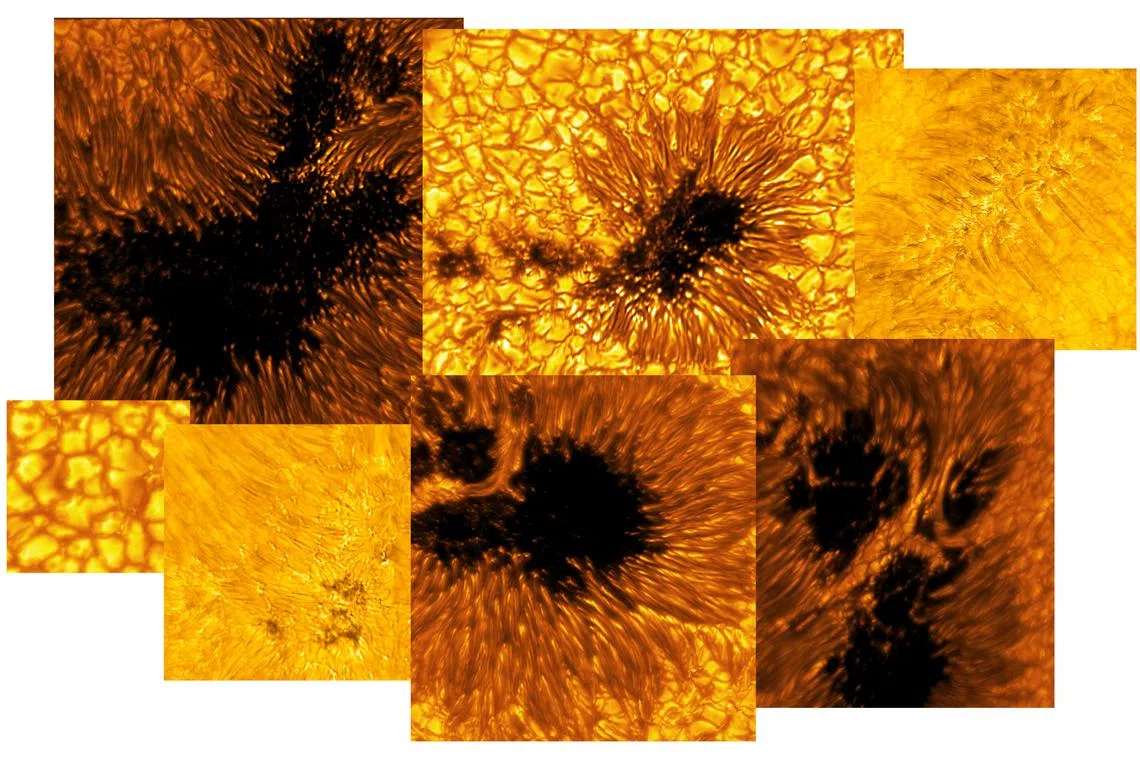Stunning new images of sunspots reveal boiling cauldrons of spaghetti-like filaments and glowing dots
Sign up now: Get ST's newsletters delivered to your inbox

A mosaic of new solar images produced by the Inouye Solar Telescope in Hawaii, the world's largest solar observatory.
PHOTO: NATIONAL SCIENCE FOUNDATION
Follow topic:
Dramatic new, high-resolution images of sunspots have revealed a psychedelic menagerie of red and orange tendrils emanating out of deep brown spaces that seem to be both a solace from the violent forces that animate the Sun and an entrance to hell itself.
The eight images, released on May 19, were taken using the National Science Foundation’s (NSF) Daniel K. Inouye Solar Telescope in Hawaii, the largest solar observatory in the world.
The researchers zeroed in on sunspots, with the Sun becoming increasingly more active as its 11-year solar cycle – when a powerful magnetic field slowly flips its poles – peaks in 2024 or 2025.
Sunspots are patches on the Sun’s surface caused by intense magnetic activity, with the darkest parts reflecting the coldest regions.
Clusters of sunspots cause solar flares and coronal mass ejections — when plasma and parts of the magnetic field pinch off from the Sun’s outer atmosphere, or corona, and go streaming across space.
Powerful solar storms can occasionally wreak havoc on Earth’s magnetic field by knocking out power grids, disrupting satellites or posing hazards to astronauts in space.
The newly released images of sunspots – which are 2.5 times higher than previous ones – reveal the dark centre of one sunspot, which is cooler but still burns at over 4,000 deg C and massive enough to swallow all of Earth, surrounded by red and orange, spaghetti-like filaments and glowing dots.
One photo closely resembles a close-up shot of the living thing that most closely resembles the Sun: the sunflower.
The images reveal the interplay of hot and cold gas on the Sun’s surface that is sculpted by a convergence of intense magnetic fields.
Bright hot plasma flows upward, while darker, cooler plasma flows down, forming the centre of a sunspot and the tendrils emanating from it.
One image shows what are known as “almost-spots”, or pores, where the magnetic fields have yet to gain enough energy to control gaseous motions on the Sun’s surface.
Another reveals “light bridges” – bright solar features that span the darkest region of a sunspot.
Scientists hope the Inouye Solar Telescope, once it reaches its full potential, will give them answers to key questions about the Sun, including the origin of solar storms.
“As the Inouye Solar Telescope continues to explore the Sun, we expect more new and exciting results from the scientific community – including spectacular views of our solar system’s most influential celestial body,” the National Solar Observatory said in a statement.


